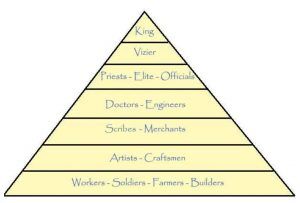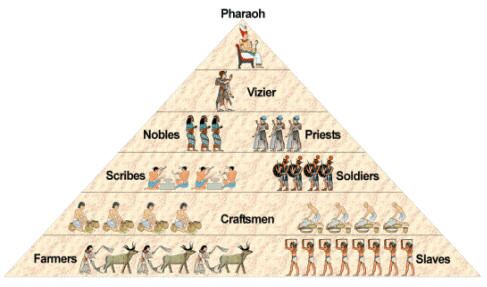Egyptian social classes were a fascinating topic of study for historians.

The ancient Egyptian people were grouped in a hierarchical system with the Pharaoh at the top and farmers and slaves at the bottom. Egyptian social classes had some porous borders but they were largely fixed and clearly delineated, not unlike the medieval feudal system. Clearly, the groups of people nearest the top of society were the richest and most powerful.
The diagram above shows the structure of Egyptian social classes in ancient times.
“But What Social Class Were The Pyramid Builders?”
For the full “History Unplugged” podcast, click here!
At the top of the variety of Egyptian social classes, the Pharaoh was believed to be a God on earth and had the most power. He was responsible for making laws and keeping order, ensuring that Egypt was not attacked or invaded by enemies, and for keeping the Gods happy so that the Nile flooded and there was a good harvest.
The Vizier was the Pharaoh’s chief advisor and was sometimes also the High Priest. He was responsible for overseeing the administration and all official documents had to have his seal of approval. He was also responsible for the supply of food, settling disputes between nobles and the running and protection of the Pharaoh’s household.
Nobles ruled the regions of Egypt (Nomes). They were responsible for making local laws and keeping order in their region.
Priests were responsible for keeping the Gods happy. They did not preach to people but spent their time performing rituals and ceremonies to the God of their temple.
Scribes were the only people who could read and write and were responsible for keeping records. The ancient Egyptians recorded things such as how much food was produced at harvest time, how many soldiers were in the army, numbers of workers and the number of gifts given to the Gods. These were the most important members of the Egyptian social classes, as far as historians were concerned.
Soldiers were responsible for the defense of the country. Many second sons, including those of the Pharaoh, often chose to join the army. Soldiers were allowed to share riches captured from enemies and were also rewarded with land for their service to the country. For fairly obvious reasons, soldiers were an indispensable part of Egyptian social classes.
Another segment of the Egyptian social classes that were appreciated were the craftsman. Craftsmen were skilled workers such as – pottery makers, leatherworkers, sculptors, painters, weavers, jewelry makers, shoemakers, tailors. Groups of craftsmen often worked together in workshops.
Contributing further to the Egyptian social classes were the farmers. Farmers worked the land of the Pharaoh and nobles and were given housing, food and clothes in return. Some farmers rented land from nobles and had to pay a percentage of their crop as their rent.
From the standpoint of Egyptian social classes, there were no slave markets or auctions in Ancient Egypt. Slaves were usually prisoners captured in war. Slaves could be found in the households of the Pharaoh and nobles, working in mines and quarries and also in temples.
This article is part of our larger selection of posts about Ancient Egypt. To learn more, click here for our comprehensive guide to Ancient Egypt.
Cite This Article
"Egyptian Social Classes and Society: How Exactly Did It Work?" History on the Net© 2000-2024, Salem Media.
April 24, 2024 <https://www.historyonthenet.com/egyptian-social-classes>
More Citation Information.
